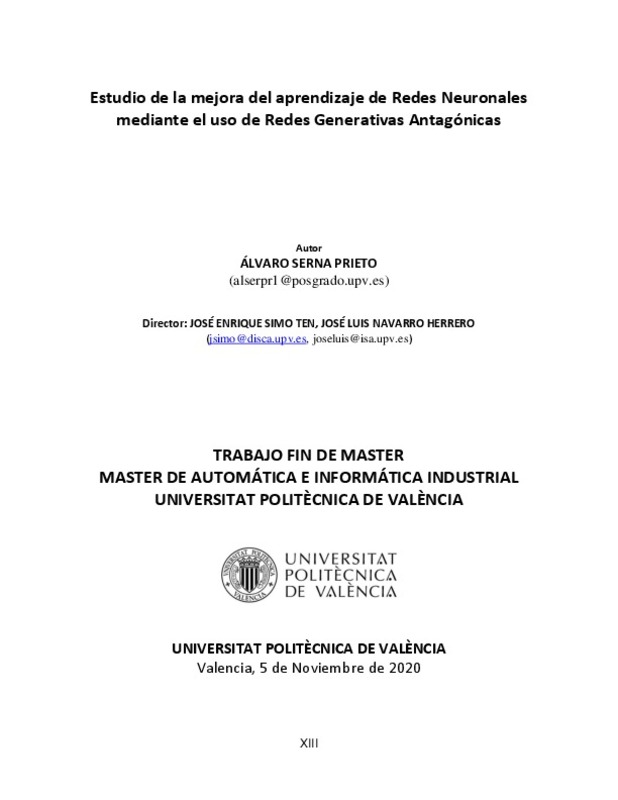|
Resumen:
|
[ES] La Inteligencia Artificial y el Machine Learning (aprendizaje automático) han sido unas de las tecnologías recientes que más se han desarrollado en los últimos años, hasta llegar al punto, de ser muchas ...[+]
[ES] La Inteligencia Artificial y el Machine Learning (aprendizaje automático) han sido unas de las tecnologías recientes que más se han desarrollado en los últimos años, hasta llegar al punto, de ser muchas veces incorporadas en los nuevos entornos industriales, proporcionando gran variedad de aplicaciones y herramientas para mejorar la productividad y eficiencia de las industrias. Este trabajo fin de máster, se basa en el estudio y desarrollo de un tipo de redes neuronales, las redes generativas antagónicas (o redes GAN), para aplicarlas en el entrenamiento de otra red neuronal. Estas redes son capaces de generar imágenes falsas, pero suficientemente plausibles, como para engañar incluso al ojo humano. Con ello lo que se pretende es generar un banco de imágenes lo suficientemente grande como para que, al entrenar la red ya desarrollada, se mejoren los resultados de precisión de la misma para clasificar imágenes (en este caso de productos alimentarios como son las golosinas). Para ello, se realizará un recorrido sobre el estado actual de la Inteligencia Artificial, diferenciando conceptos como Machine Learning o Deep Learning, viendo que son las redes neuronales y cómo se construyen, analizando lo que son las redes convolucionales utilizadas en este trabajo y por último viendo en detalle en qué se basa una red GAN y cuáles son las herramientas para desarrollar todas estas redes. Con esos conocimientos se pasa a obtener ejemplos de redes GAN de Internet con pruebas de éxito en sus respectivos campos, una con imágenes de dígitos manuscritos y otra con pequeñas imágenes a color. Estas redes se analizarán y se podrán comprobar sus resultados después de entrenarlas, para después modificarlas al caso de estudio de este trabajo. Con estas adaptaciones se podrán generar imágenes falsas con cada red y ver que red es capaz de generar las imágenes más plausibles, que serán utilizadas para el entrenamiento de la red desarrollada en el trabajo fin de grado en el que se basa este estudio.
[-]
[EN] Artificial Intelligence and Machine Learning (Automatic Learning) have been one of the recent technologies that have been most developed in recent years, to the point of being many times incorporated into new industrial ...[+]
[EN] Artificial Intelligence and Machine Learning (Automatic Learning) have been one of the recent technologies that have been most developed in recent years, to the point of being many times incorporated into new industrial environments, providing a great variety of applications and tools to improve productivity and efficiency in industries. This master's thesis is based on the study and development of a type of neural networks, antagonistic generative networks (or GAN networks), to apply them in the training of another neural network. These networks are capable of generating false images, but plausible enough to fool even the human eye. With this, the aim is to generate an image bank large enough so that, by training the already developed network, the precision results of the network are improved to classify images (in this case of food products such as sweets).To do this, a tour will be carried out on the current state of Artificial Intelligence, differentiating concepts such as Machine Learning or Deep Learning, seeing what neural networks are and how they are built, analyzing what are the convolutional networks used in this work and finally seeing in detail what a GAN network is based on and what are the tools to develop all these networks. With this knowledge, we obtain examples of Internet GAN networks with success tests in their respective fields, one with images of handwritten digits and another with small color images. These networks will be analyzed and their results can be verified after training them, and then modified to the case study of this work. With these adaptations, it will be possible to generate false images with each network and see which network is capable of generating the most plausible images, images that will be used for training the network developed in the final degree project on which this one is based.
[-]
|







